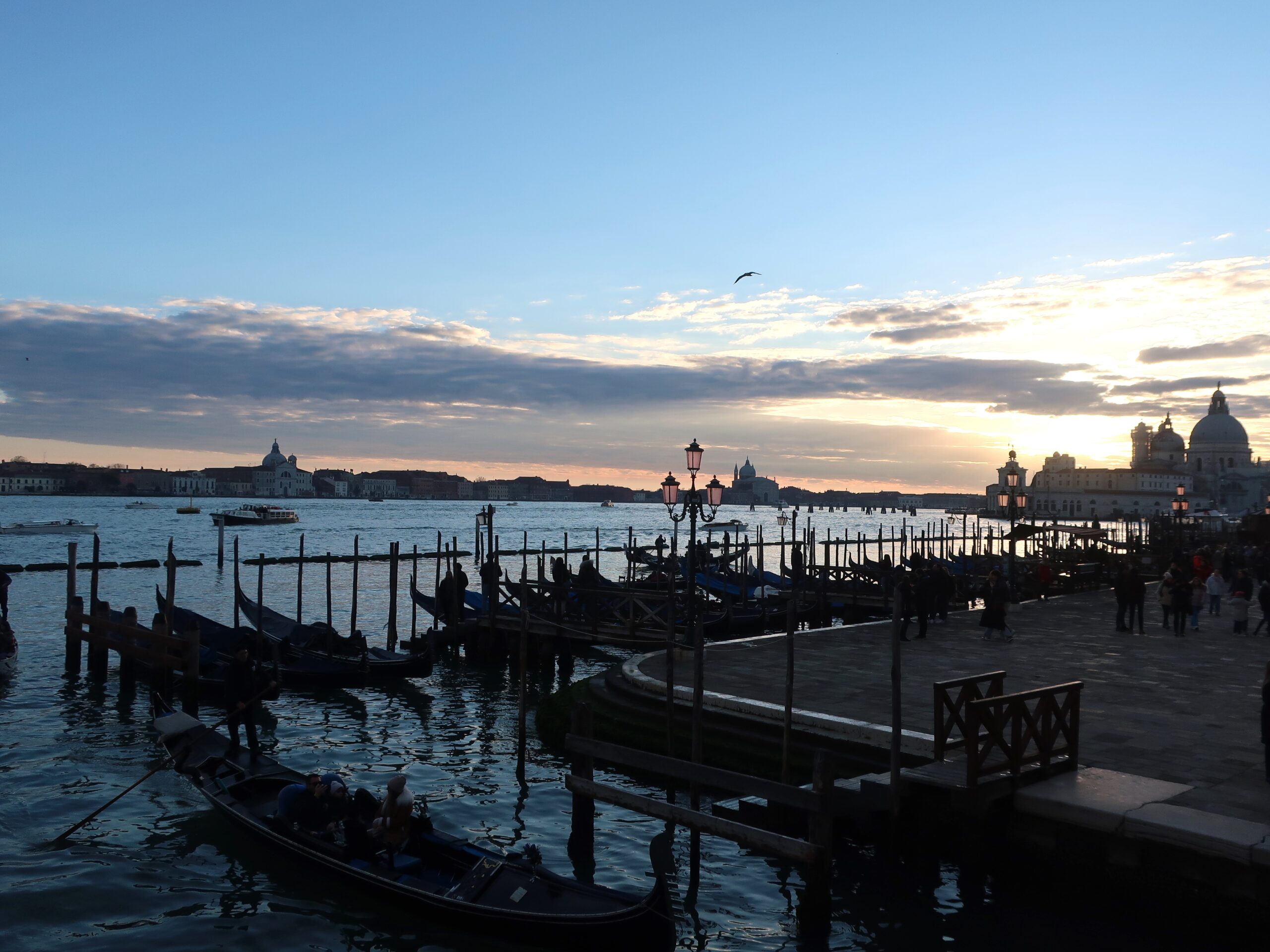Table of Contents
Travels in Venice] (23) Visiting Venice, a City of Colorful Arts - What did Dostoevsky think of this beautiful city of water?
Previous Article(22) Dostoevsky's days in Florence: places associated with him and his favorite work, Raphael's "Madonna in a Little Chair!"In the following section, we introduced Mr. and Mrs. Dostoevsky in Florence.
In this article, I will talk about Venice, which the Dostoevskys visited next.
So let's hear what Mrs. Anna has to say.
Mr. and Mrs. Dostoevsky from Florence to Venice
During the nine months I spent in Italy, I learned to speak some Italian. I had no trouble talking to maids and doing my business in stores, and I could read and understand most of the newspapers such as Piccola and Secola. My husband, who was busy with his work, of course had no time to learn the language, so I interpreted for him. Now, with joy at hand, we needed to move to a country where my husband could speak French or German with the doctors, maternity nurses, and store clerks without difficulty. We talked for a long time about where we should go and what kind of place would give my husband access to the intellectual community. I suggested that he spend the winter in Prague, near Russia, as he had done in his native land. Here, my husband could make friends with the best political activists, and through them he might be able to join the literary and artistic circles there. My husband, who had repeatedly regretted not being able to attend the Slavic Congress in 1867, immediately agreed. He was sympathetic to the pan-Slavic movement in Russia and wanted to get to know the people there better. Thus, I finally decided to go to Prague and spend the winter there. My physical condition did not allow me to travel, so I decided to take breaks in several cities along the way. I had planned to go to Venice first, but I stopped in Bologna and went to see Raphael's "Santa Cecilia" at the museum there. He had only seen it as a reproduction, but he seemed very happy to see the original. It took me a lot of effort to pull my husband away from standing there in front of this magnificent painting, fearing that the train would leave.
Misuzu Shobo, Anna Dostoevskaya, translated by Hiroshi MatsushitaDostoevsky in Recollection."p204
During their stay in Florence, they found out that Mrs. Anna was expecting her second child, and they were thinking of moving.
Prague was on the short list. I will talk about this city later, but the Dostoevsky couple first stopped in Bologna on their way to Prague. I decided to follow their lead and make a stopover in Florence.
Raphael's "Santa Cecilia" at the National Gallery of Bologna
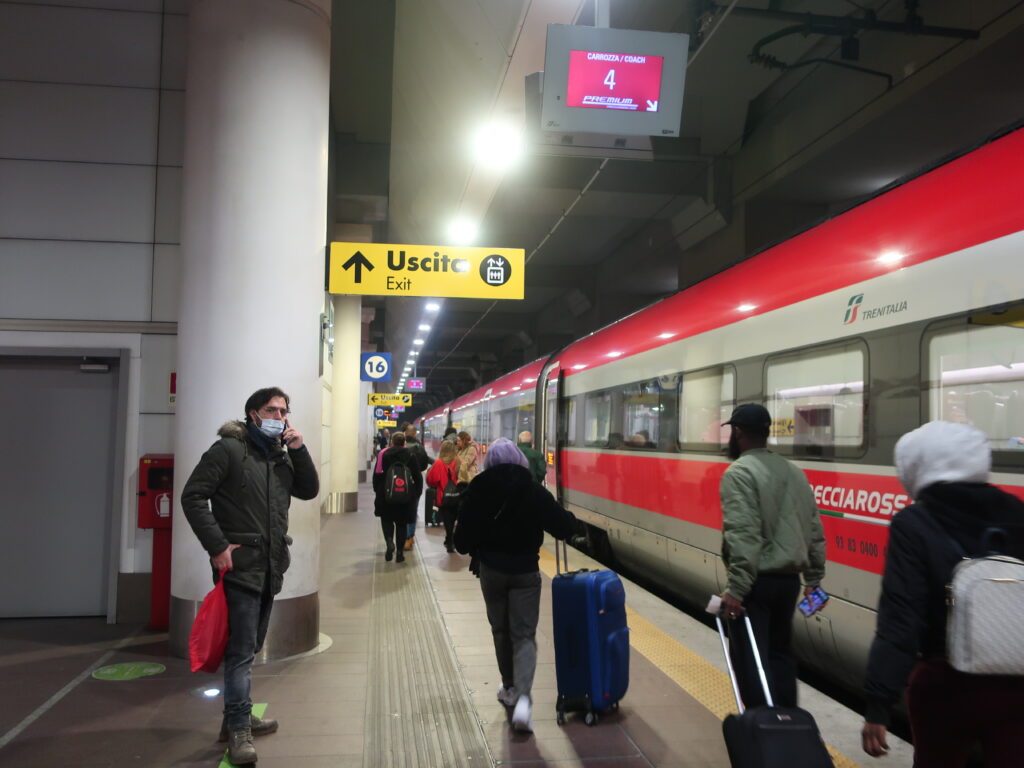
It takes about 40 minutes from Florence to Bologna by high-speed train. It is closer than expected.
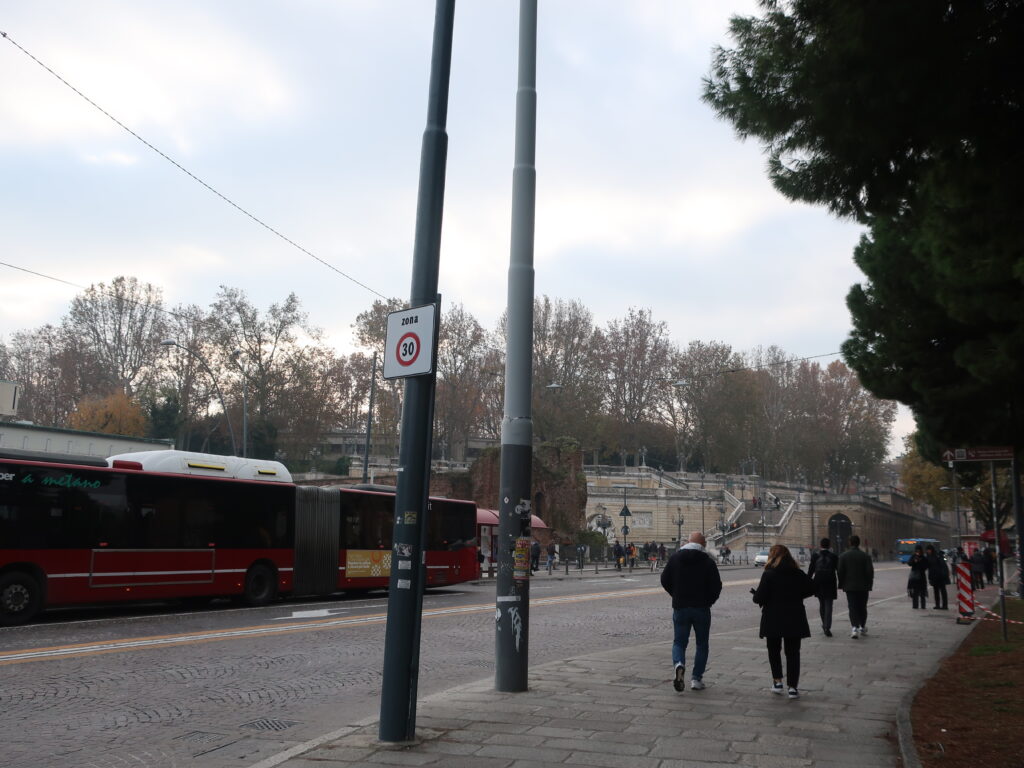
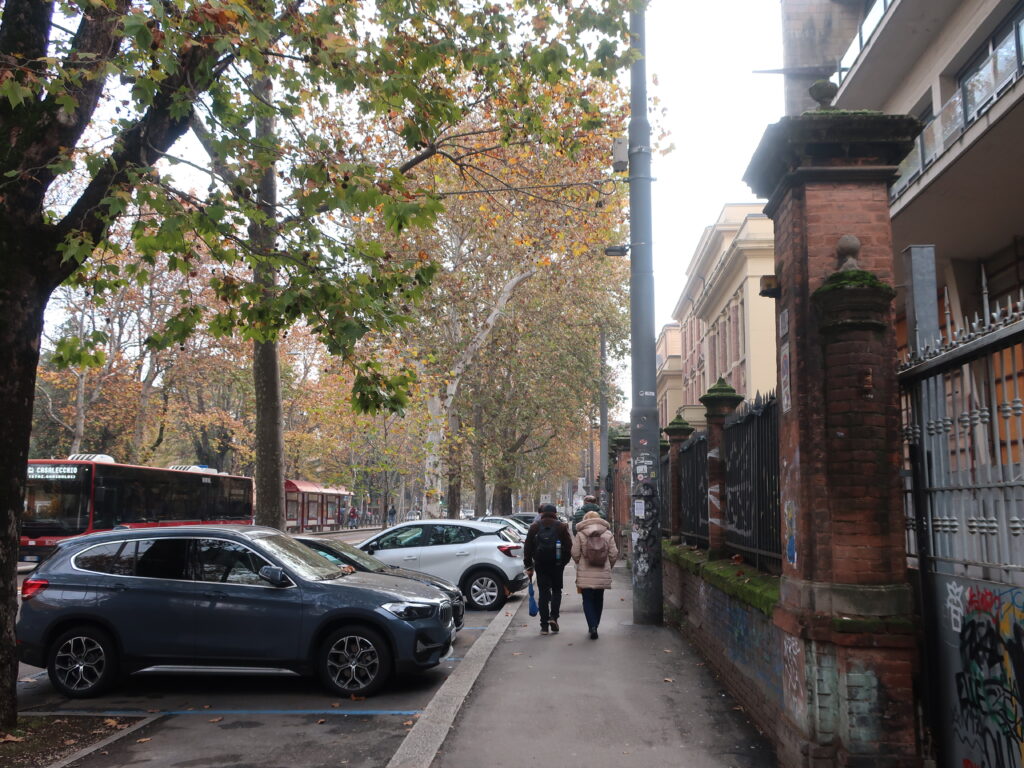
Raphael's "Santa Cecilia" seen by Dostoevsky and his wife is now on display at the National Picture Gallery of Bologna. It is about a 20-minute walk from the station.
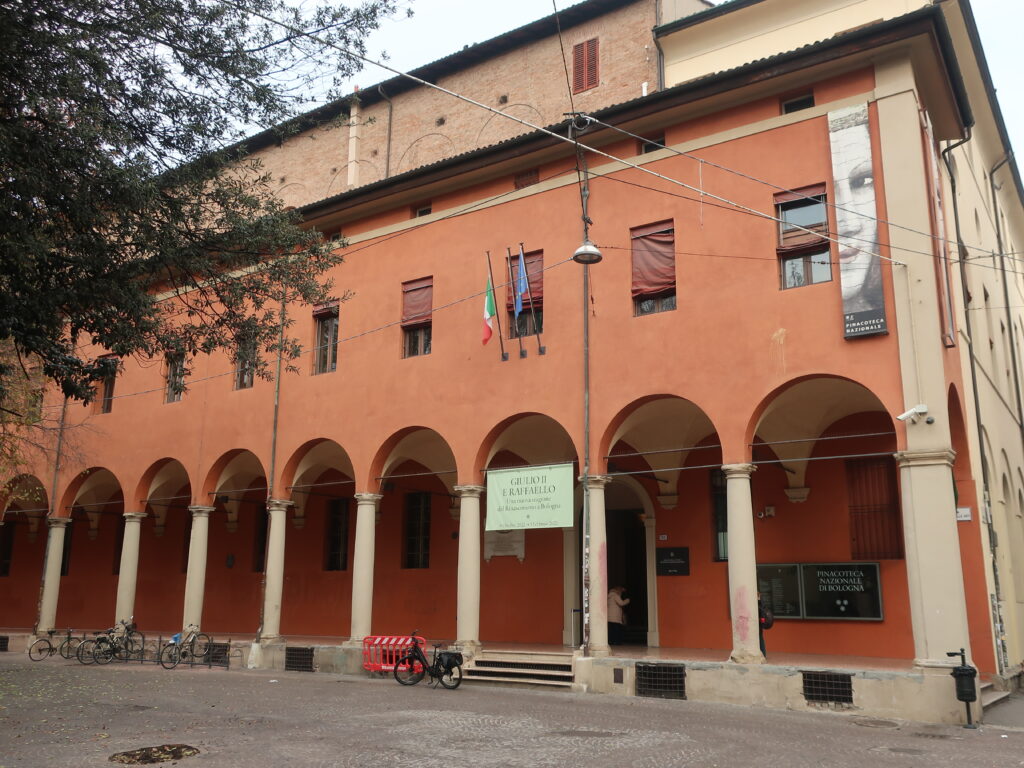
This is the Bologna National Picture Gallery. I enter the museum as soon as possible.
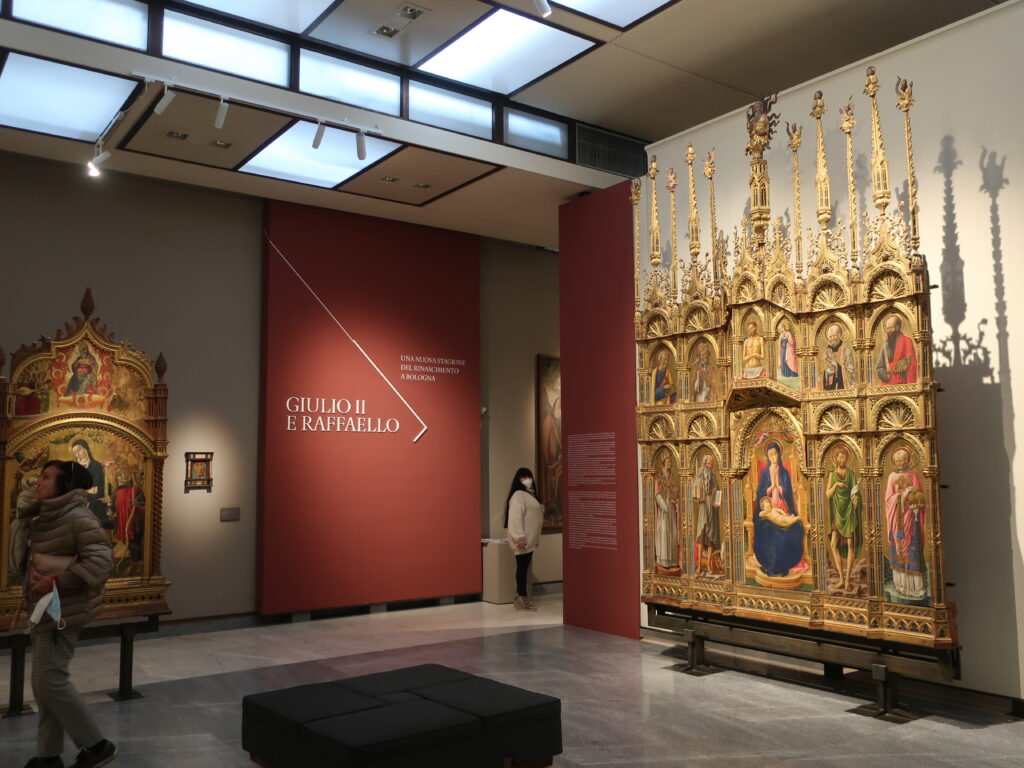
Due to train time, I, like Mr. and Mrs. Dostoevsky, had no time. At once I headed for the Raphael painting.
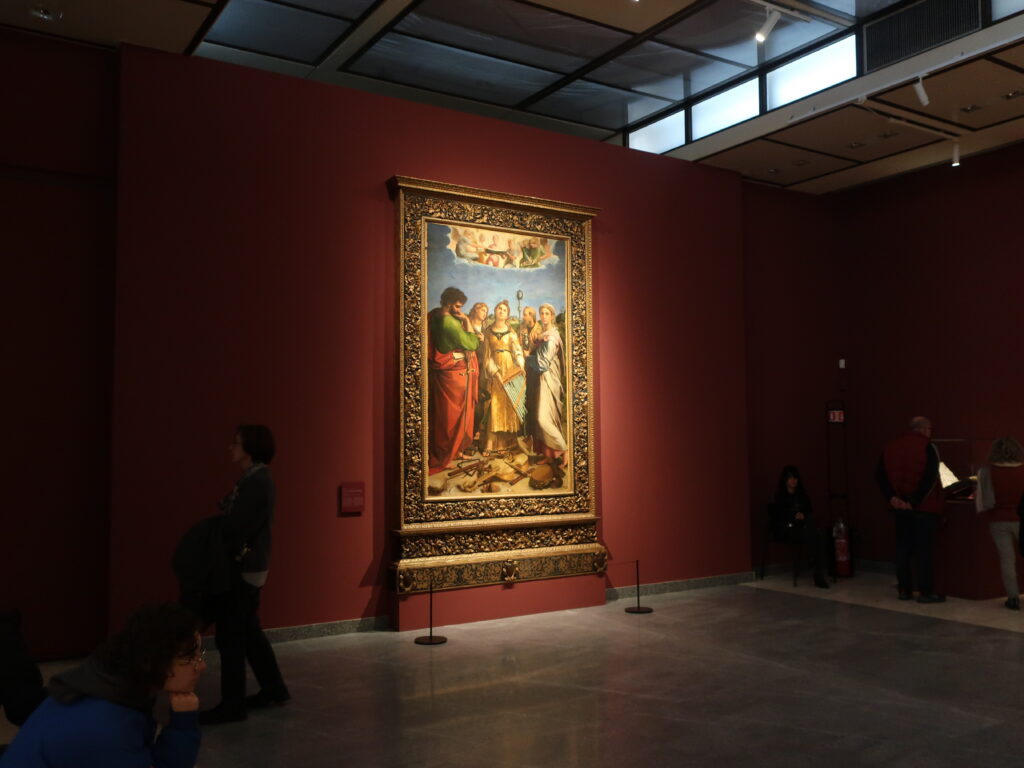
This is the "Santa Cecilia" that Dostoevsky stood on. It is a bigger picture than I expected. Let's get a little closer.
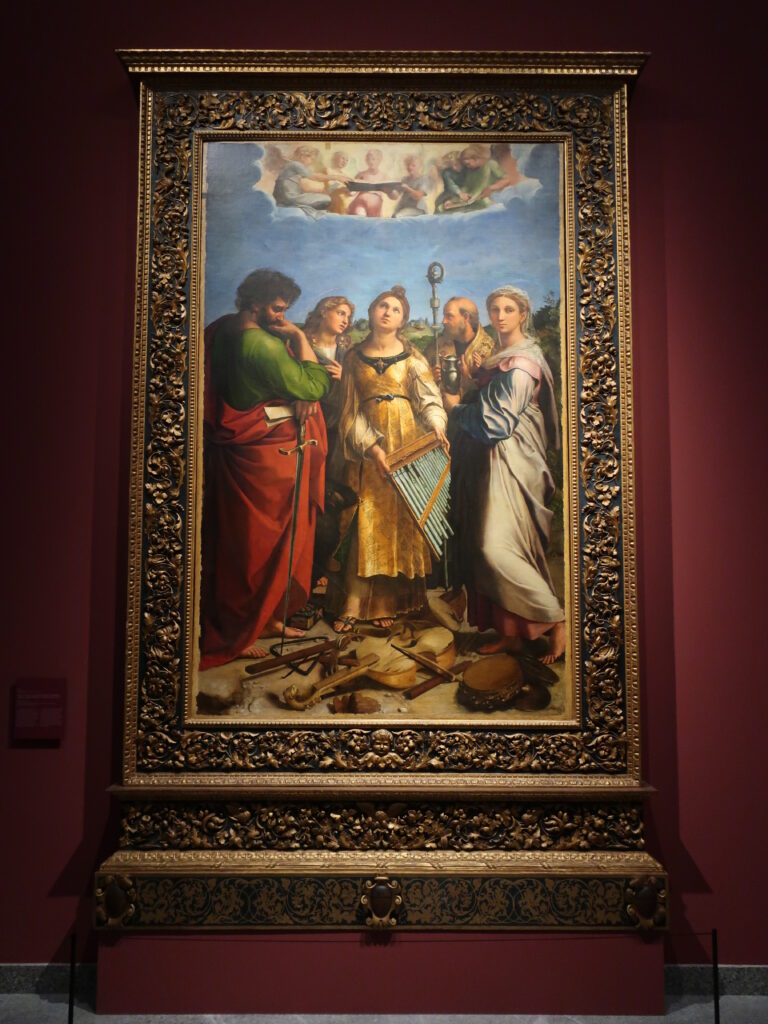
Santa Cecilia (St. Cecilia) was a martyr of the Roman Empire around the second century and is famous as the patron saint of musicians and the blind.
That is why this painting also depicts a musical instrument. However, it is a very strange composition in which a broken instrument is placed carelessly at the feet of the patron saint of music. The depiction of each person's face, pose, and clothing is unmistakably Raphael-like. Dostoevsky, who is an unparalleled Raphael lover, must have found this work to be a perfect fit for him.
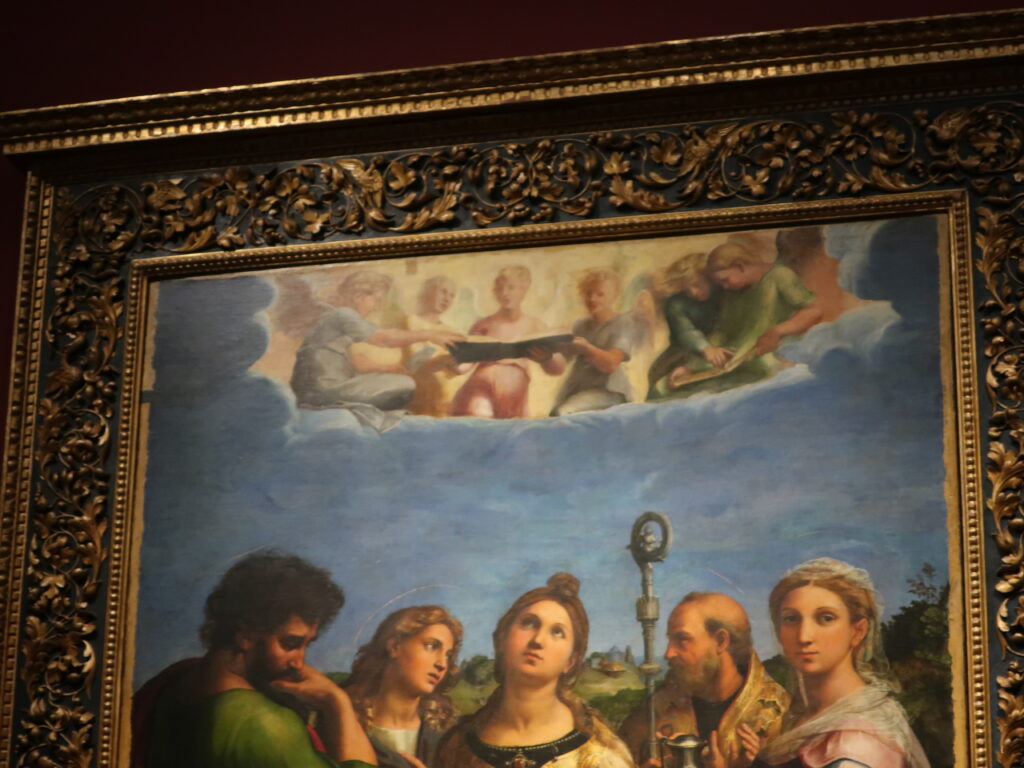
I remember that the joyful look of the angels above my head was strangely impressive. This expression is even more meaningful to me because the Santa Cecilia in the center was tragically beheaded by the Roman Empire.
Incidentally, this Santa Cecilia also has a famous sculpture in Rome.
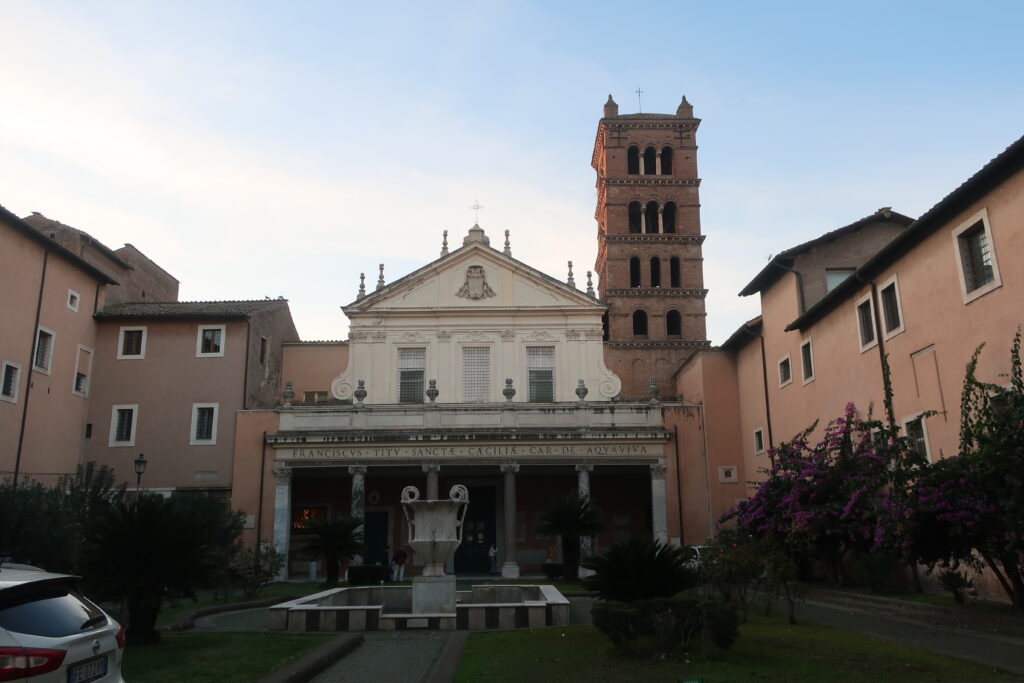
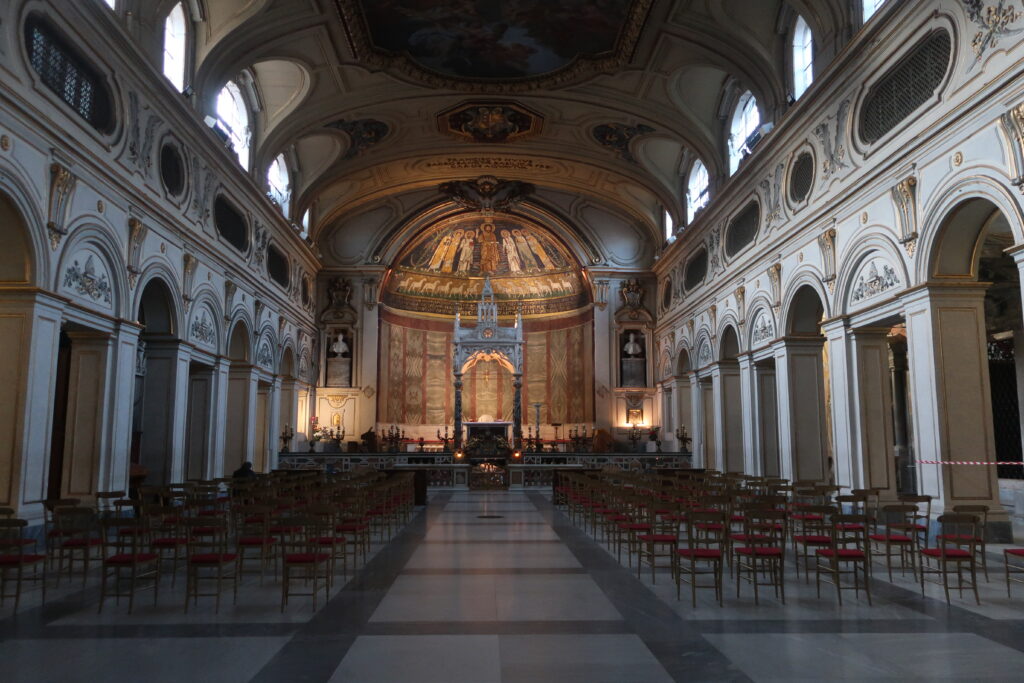
This is the Church of Santa Cecilia in Trastevere in the city of Rome. On this central altar is a work by Stefan Maderno.The Martyrdom of St. Cecilia."The work is housed in a work of art called
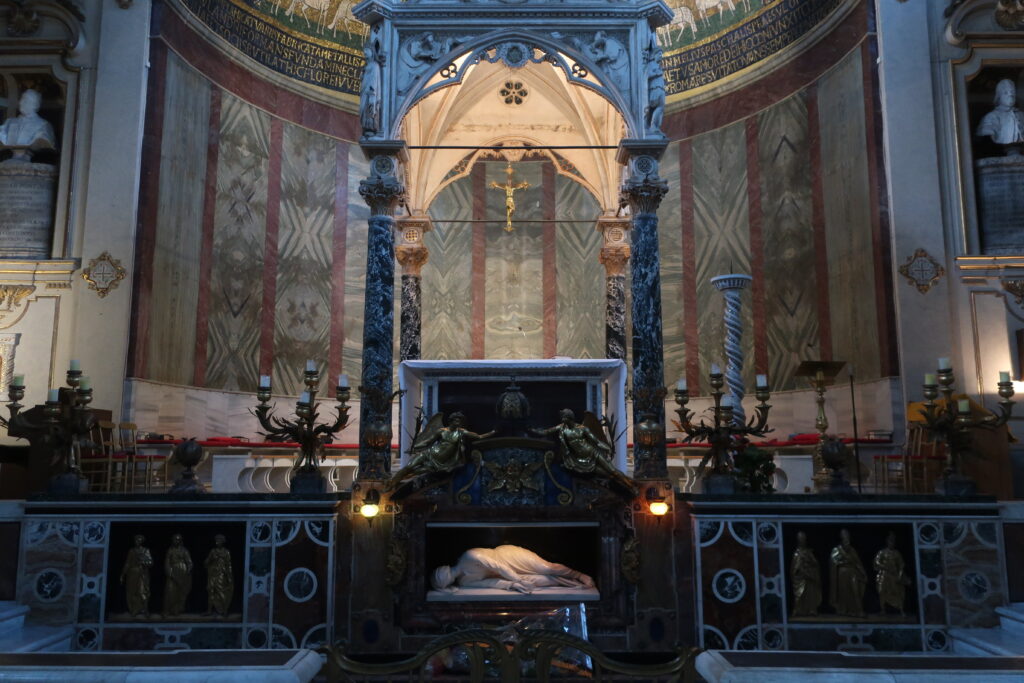
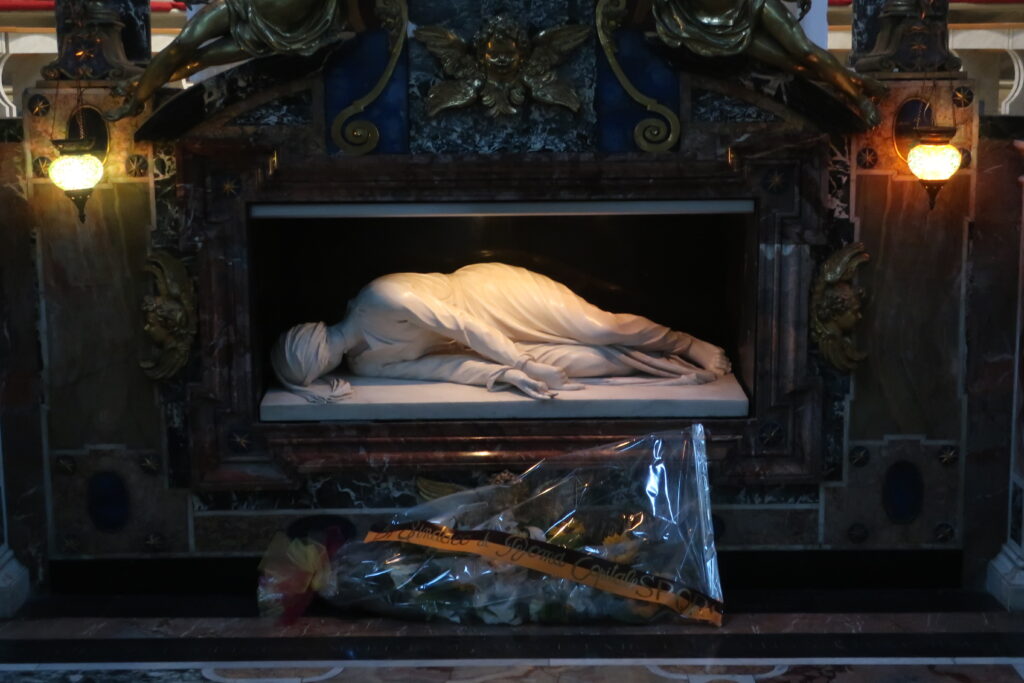
I will never forget the shock I felt when I saw this sculpture. It was not just that it was realistic, but it was an incredible shock. In fact, before coming to Florence, I stayed in Rome for about 10 days. The sculpture that shocked me the most during my stay in Rome was definitely this one. I think the power of this work is extraordinary compared to the works of Bernini and other geniuses. I couldn't help but think of this sculpture while looking at Raphael's painting.

But still, Mrs. Anna...I had to work very hard to pull my husband away from standing in front of this beautiful painting, fearing that the train would leave.It is interesting to note that he said. The intensity of Dostoevsky's sensitivity to painting is perhaps worth noting. In Dresden, he was fascinated by Raphael's "The Sistine Madonna" and Claude Lorrain's "Achis and Galatea," and in Basel he was frozen by Hans Holbein's "The Dead Christ in His Coffin. His strong interest in paintings is also evident in Florence.
Dostoevsky had a strong sensitivity to the artistic medium of painting. But he had little interest in theater or opera. Interestingly, this is the opposite of Turgenev. Turgenev was obsessed with opera and fell madly in love with opera singer Pauline Viardot, a relationship that lasted a lifetime. He even set up a mansion in Baden-Baden in pursuit of her.
And it is even more intense when it comes to another literary giant, Tolstoy. Tolstoy wrote in his later yearsWhat is Art?"As discussed in the following section, they reject art itself in the first place. If it is not morally beneficial, he denies that art is worthless.
Dostoevsky, pictorial. Turgenev, operatic and musical. Tolstoy as art critic.
The three have three different personalities and are very interesting.
With these thoughts in mind, I hurriedly departed from the picture gallery and headed for Venice.
Finally, we will go to Venice, the city of water.
We were in Venice for only three or four days, but he was so fascinated by the architecture of St. Mark's Basilica that he spent hours admiring the beautiful mosaic walls. They visited the Palazzo Ducale together, and my husband was in awe of its magnificent architecture. He was also entranced by the astonishing beauty of the ceiling of the Governor's Palace, which was painted by the best artists of the fifteenth century. It is safe to say that during our four days in Venice, we could not leave the Piazza San Marco, which left an enchanting impression day and night.
Misuzu Shobo, Anna Dostoevskaya, translated by Hiroshi MatsushitaDostoevsky in Recollection."p205
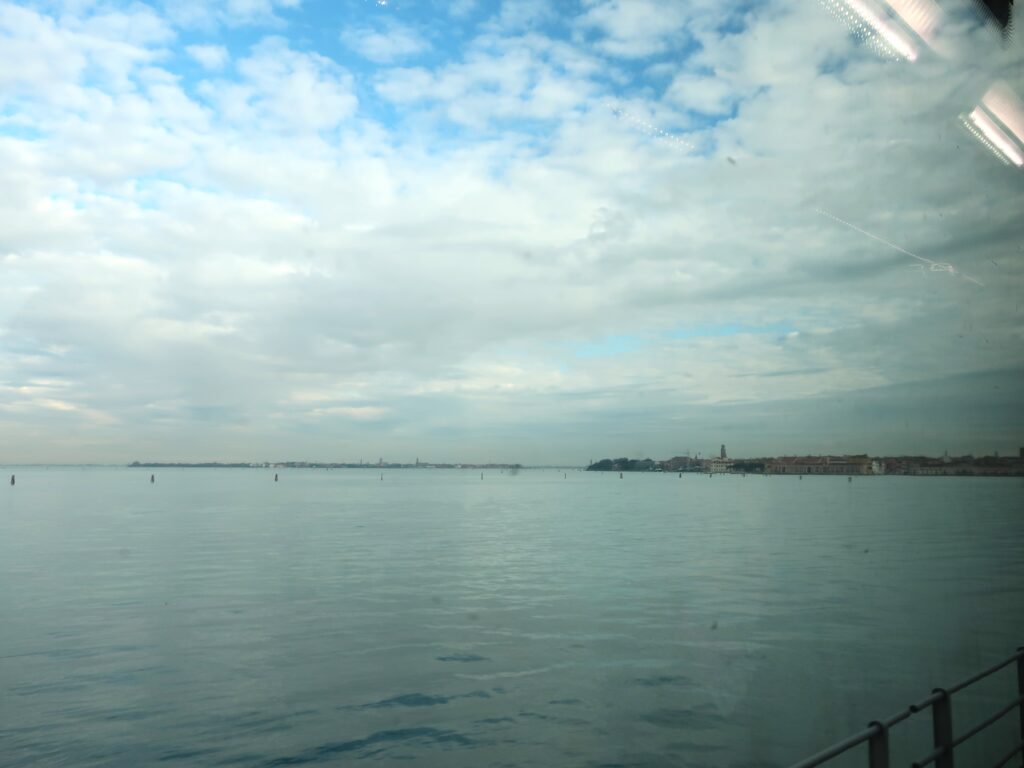
I entered Venice by train. As I approached Venice, I was impressed by the fact that the train was running on the sea. I realized that Venice is really on the sea. I remember well that I was unintentionally elated when the city began to come into view.
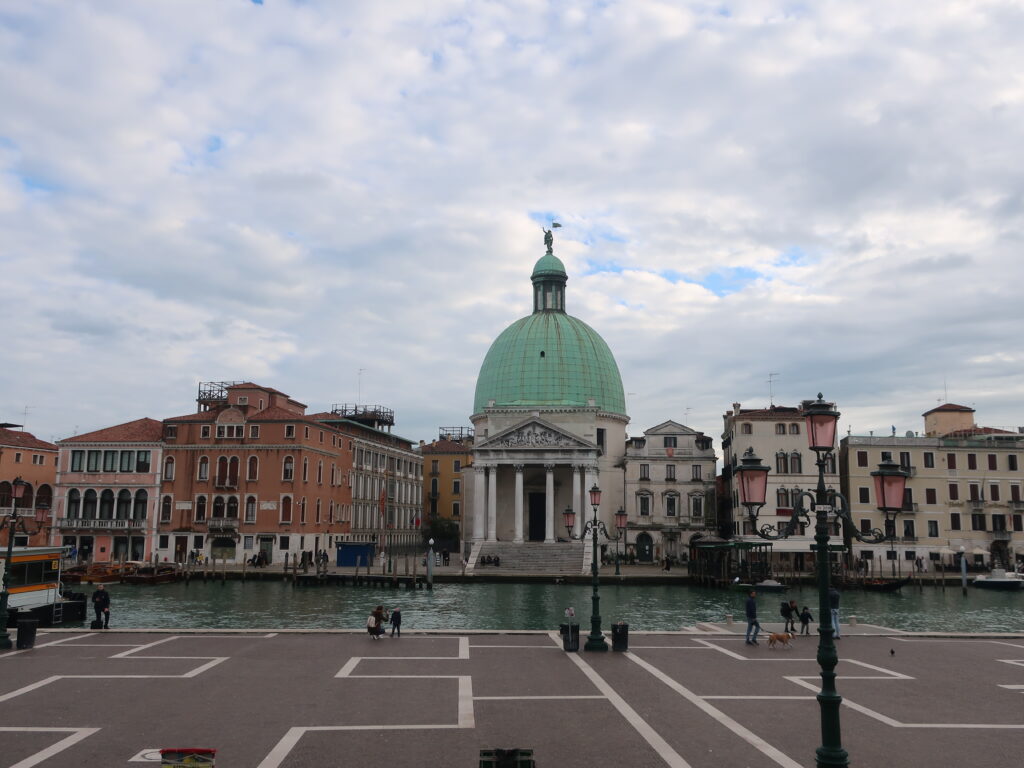
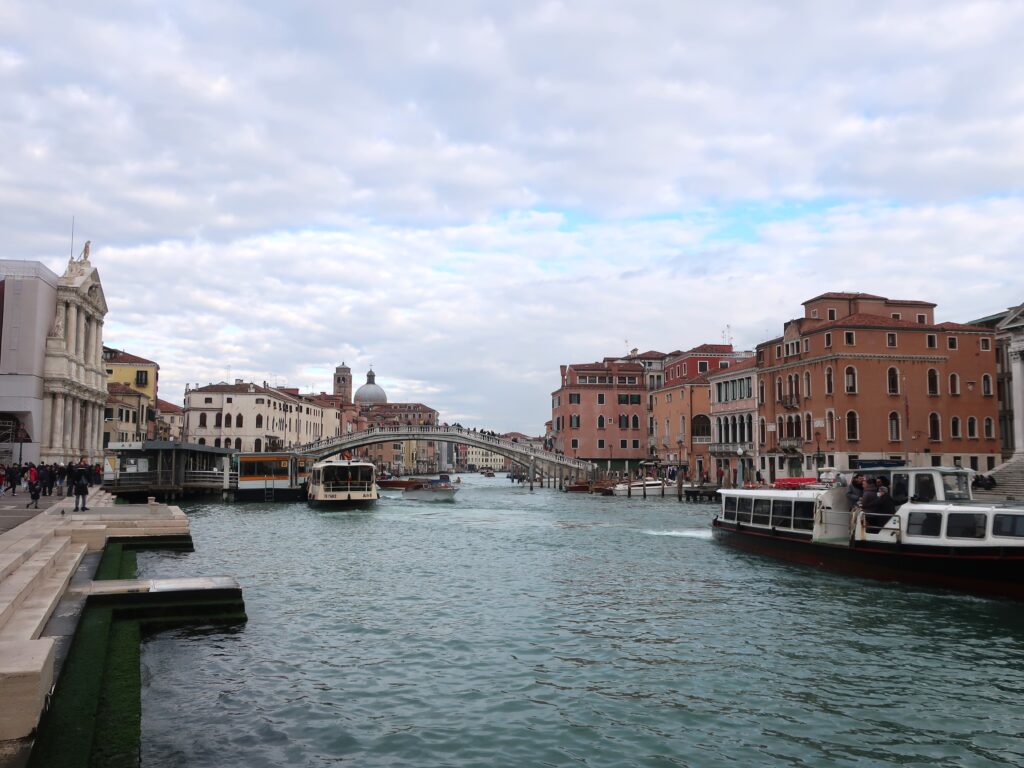
As soon as you get out of the station, you will see a canal! Oh, so this is the Venice of Venice! I couldn't help but get excited. The sense of spectacle and entertainment in this city is outstanding. It is not so easy to impress people as soon as they arrive and say "I've come to Venice! It is not so easy to impress people. It is indeed Venice.
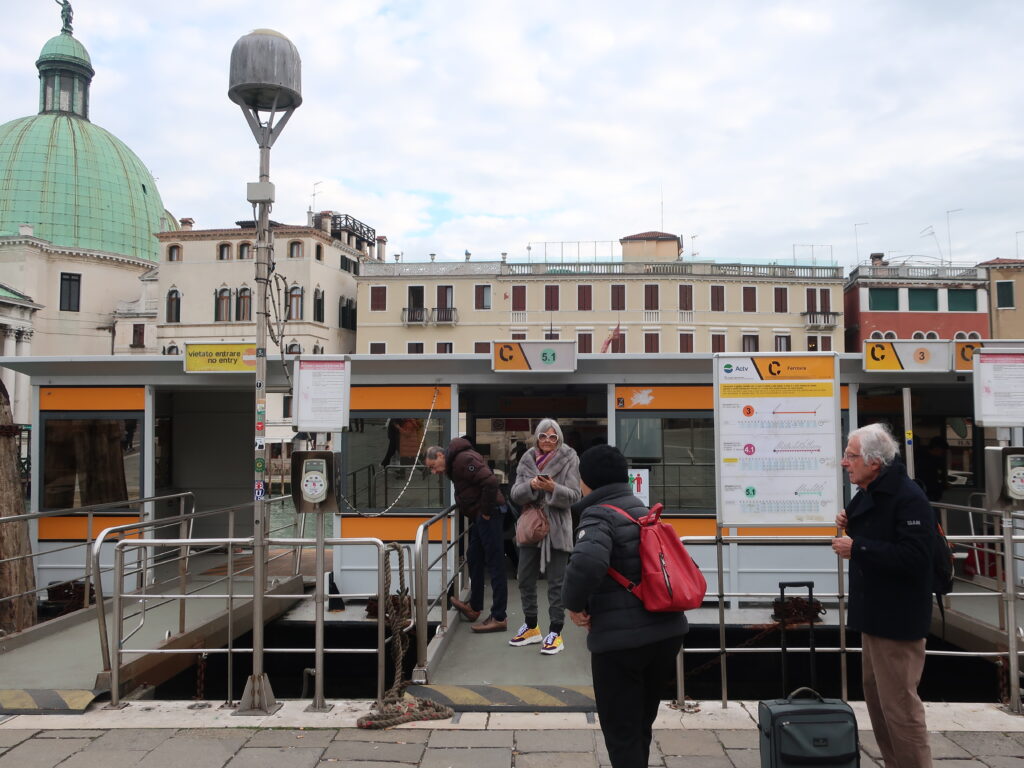

I boarded a water bus and headed for the city center. There are no cars or trains in Venice. Instead, water buses run frequently on the canals. This is also a very typical Venetian performance.
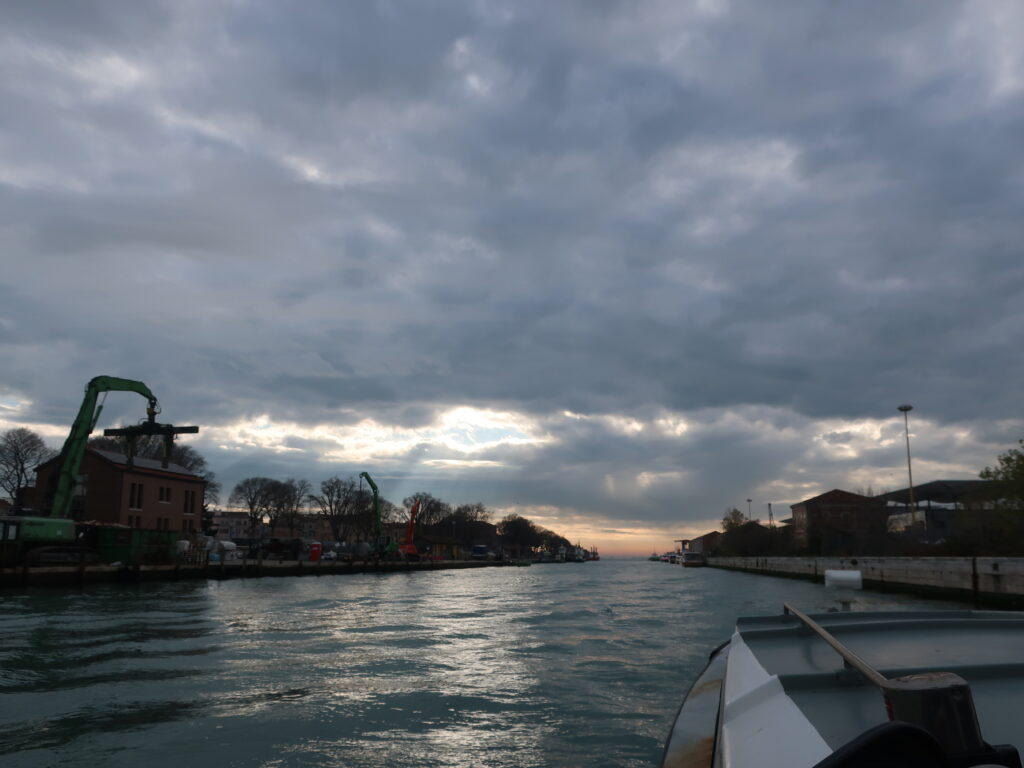
It was still early in the evening, but the other side of the sea was tinted orange.
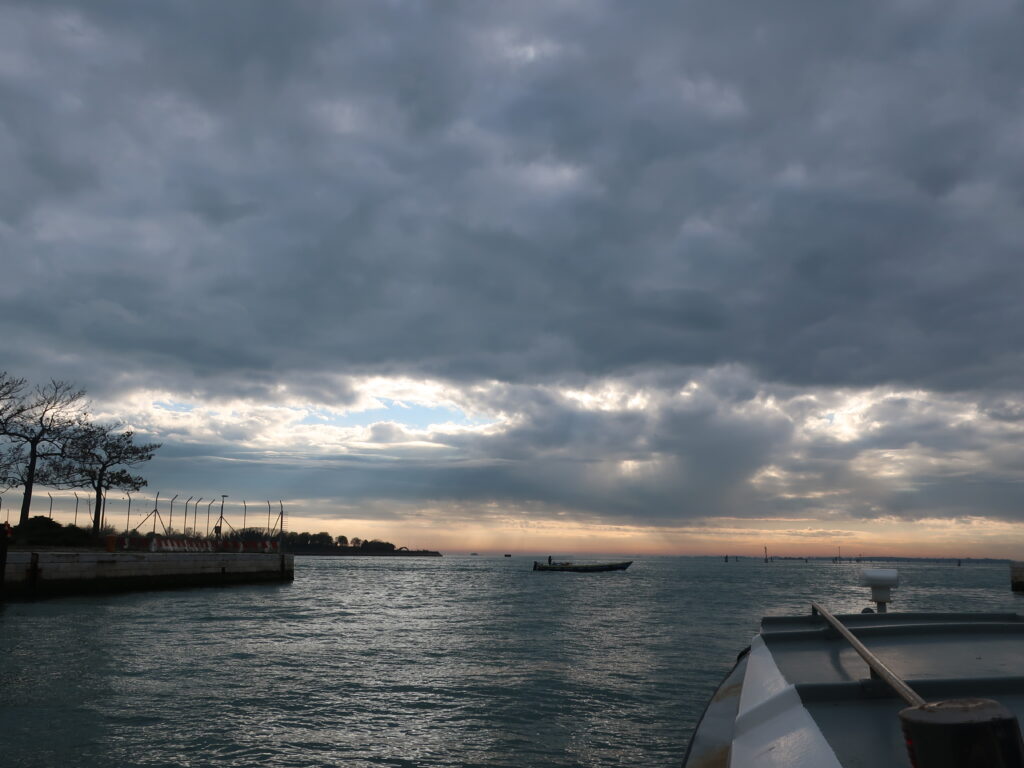
And while I was looking at this view, I had a flash of inspiration. I once read"The scheme of Venetian color against Roman line drawings."The words "I'm not a good person," came strongly into my mind.
It was stated there that Venetian painting was characterized by vivid colors.
Indeed, this view represents just that. The orange color in front of me, the shadows of the clouds, the light coming through the clouds and the light blue sky, and the deep, dark blue of the ocean...
This is exactly what Venetian painting itself is!
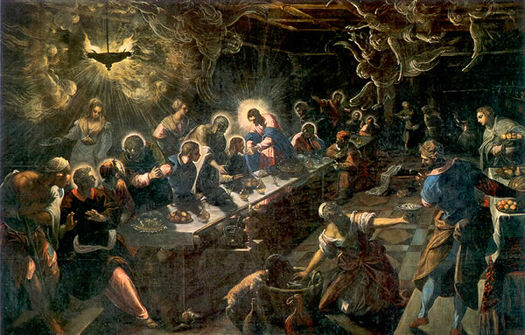
I strongly felt that the local environment shapes the local culture. It is because of this environment that these paintings are favored. Venice is already full of beautiful colors.
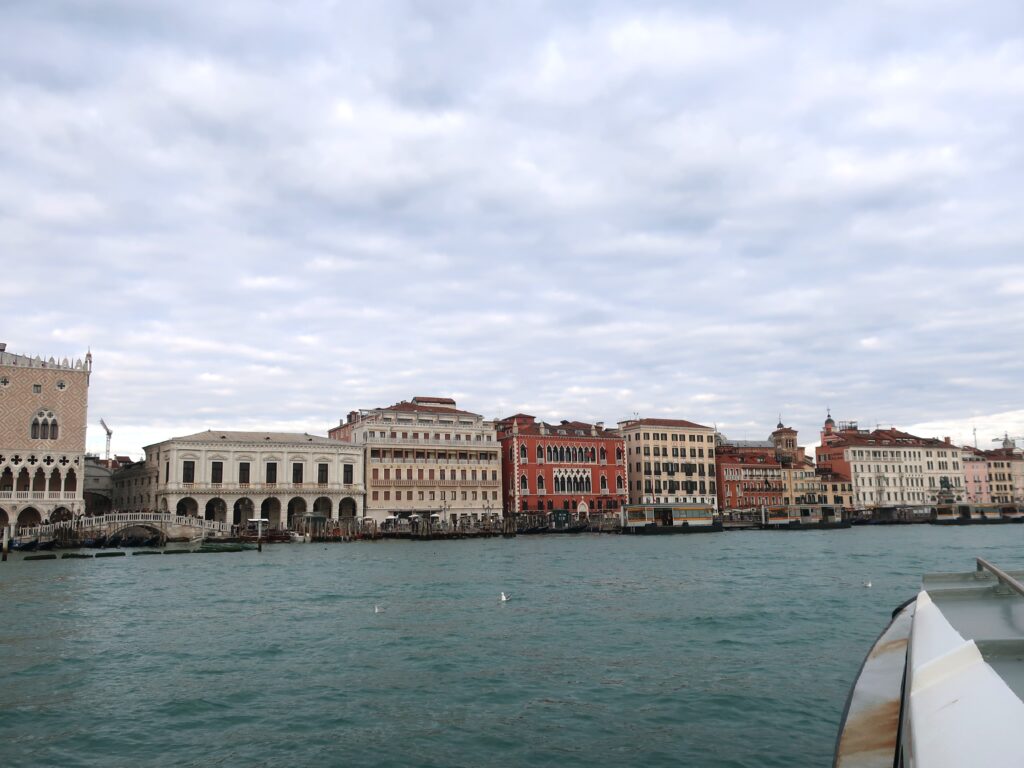
Soon we arrived at the center near Piazza San Marco.
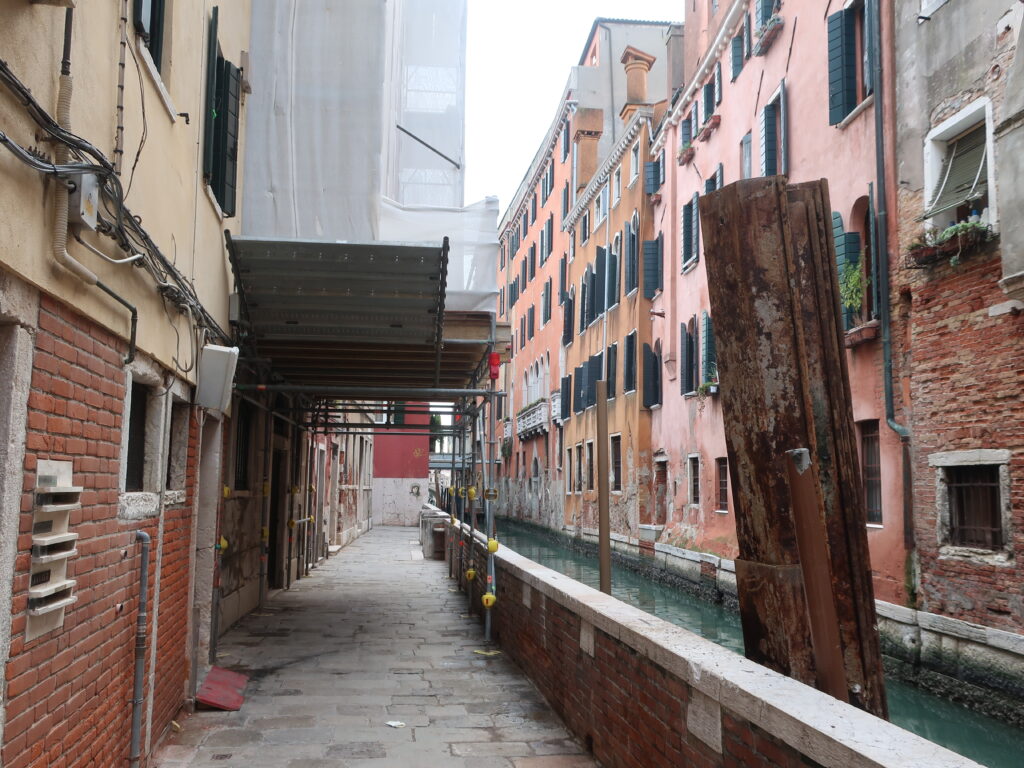
I got off the water bus and went into a nearby alley. There really is a canal from corner to corner. Even though there are gondolas, one wonders how they transport things without cars.
Let us now take a look at the city of Venice, where Mr. and Mrs. Dostoevsky also walked.
St. Mark's Basilica and St. Mark's Square, the heart of Venice
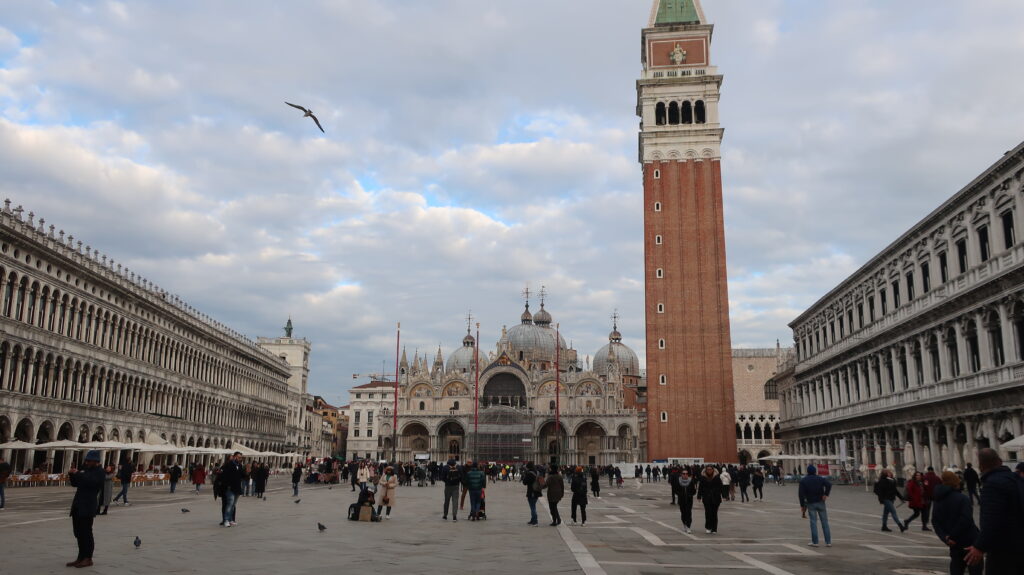
The Basilica and Piazza San Marco were praised by Dostoevsky and his wife. In a letter to his niece Sonya Ivanova, Dostoevsky also praised the Basilica of San Marco, saying, "This is an incomparable marvel (dated August 29, 1869).
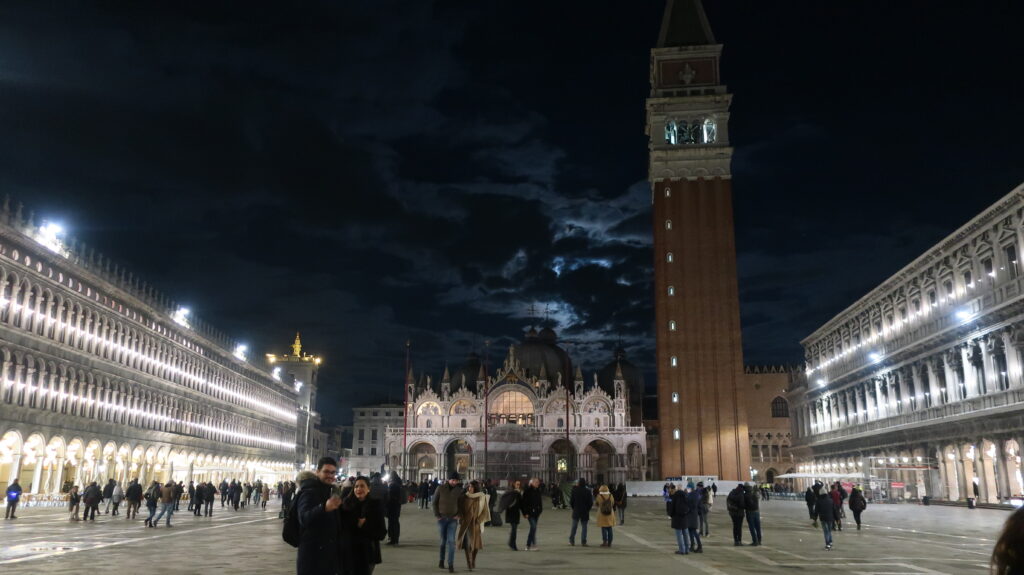
For me personally, I was more fascinated by St. Mark's Square at night than during the day. The moonlight eerily illuminated the clouds, creating a dramatic atmosphere typical of Venice. Of course, there was no electricity when Dostoevsky was there. The whole city must have been much darker. However, the moonlight was more intense, and the effect of the fire used for lighting must have been significant. I wondered which would look more beautiful: the beautifully illuminated modern era or the era of natural light alone. I wondered which looked more beautiful.
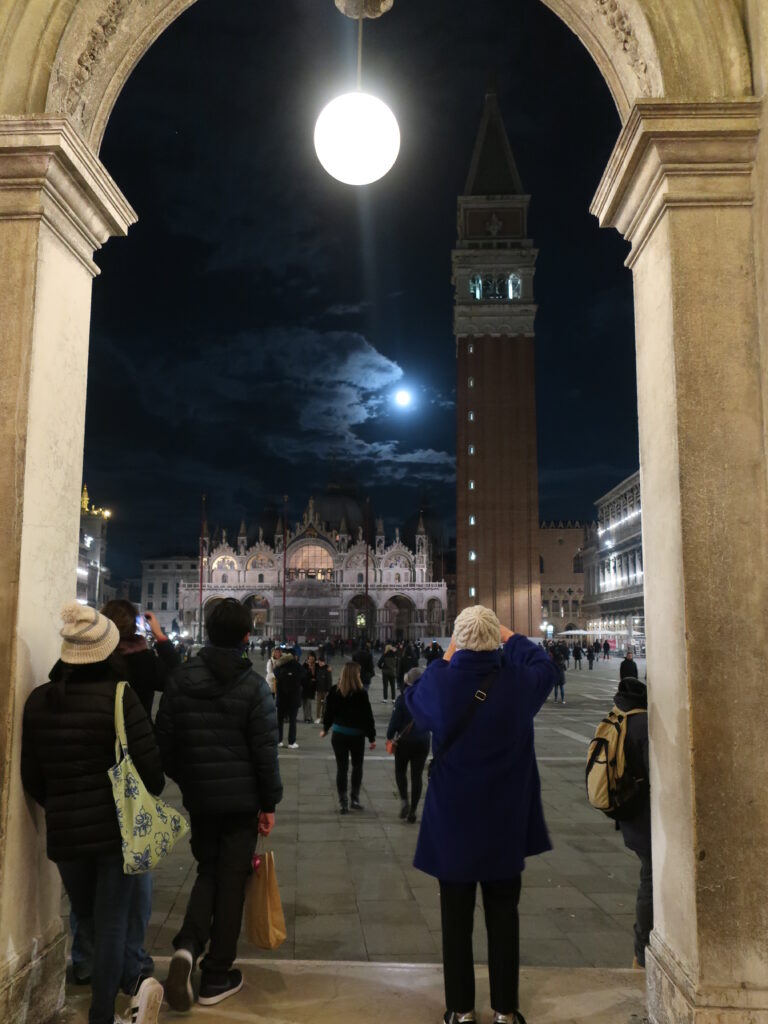
Piazza San Marco seen from between the pillars is truly a painting in a frame. Is Venice a beautiful city that never ceases to inspire artists wherever they go?
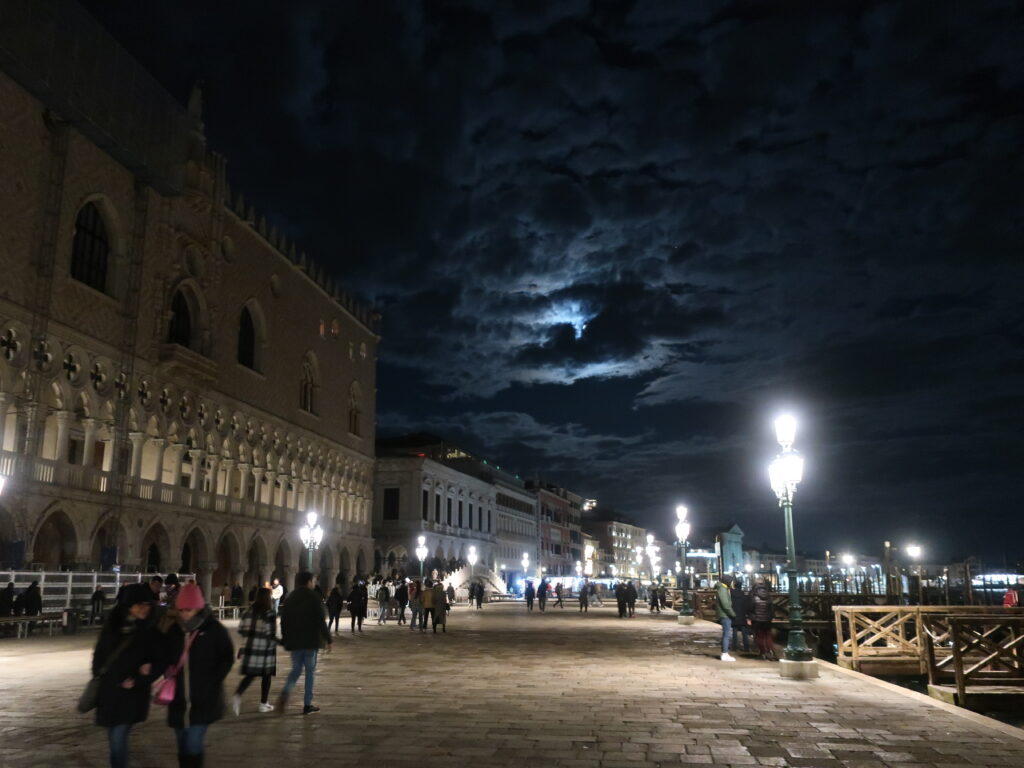
Venice by night was also wonderful. Fantastic. I see, I was very much convinced that this would give birth to Tintoretto's paintings.
Amazing ceiling paintings and murals of Palazzo Ducale, the temple of Venetian painting.
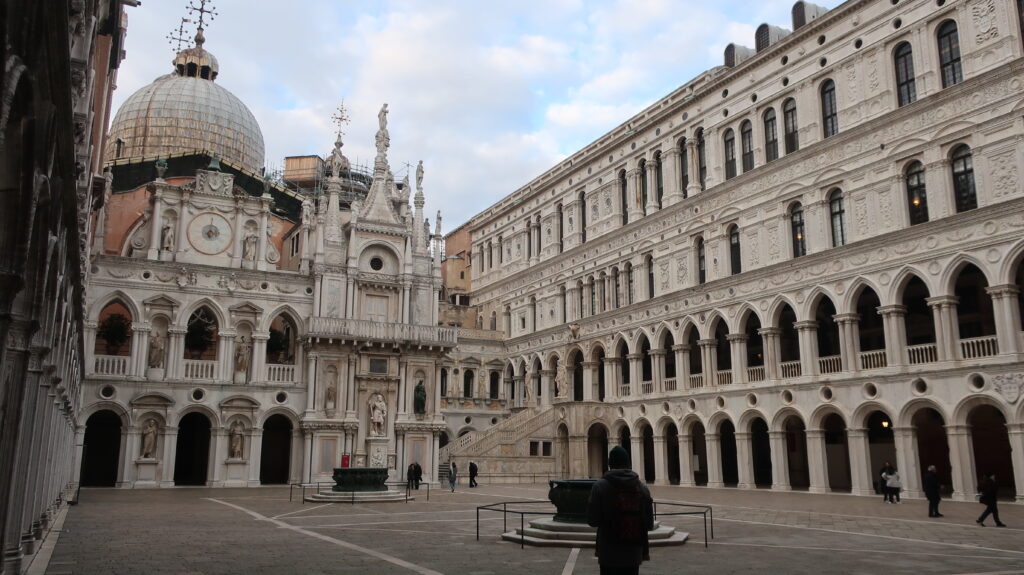
Palazzo Ducale is located near Piazza San Marco. The Dostoevsky couple also visited here.
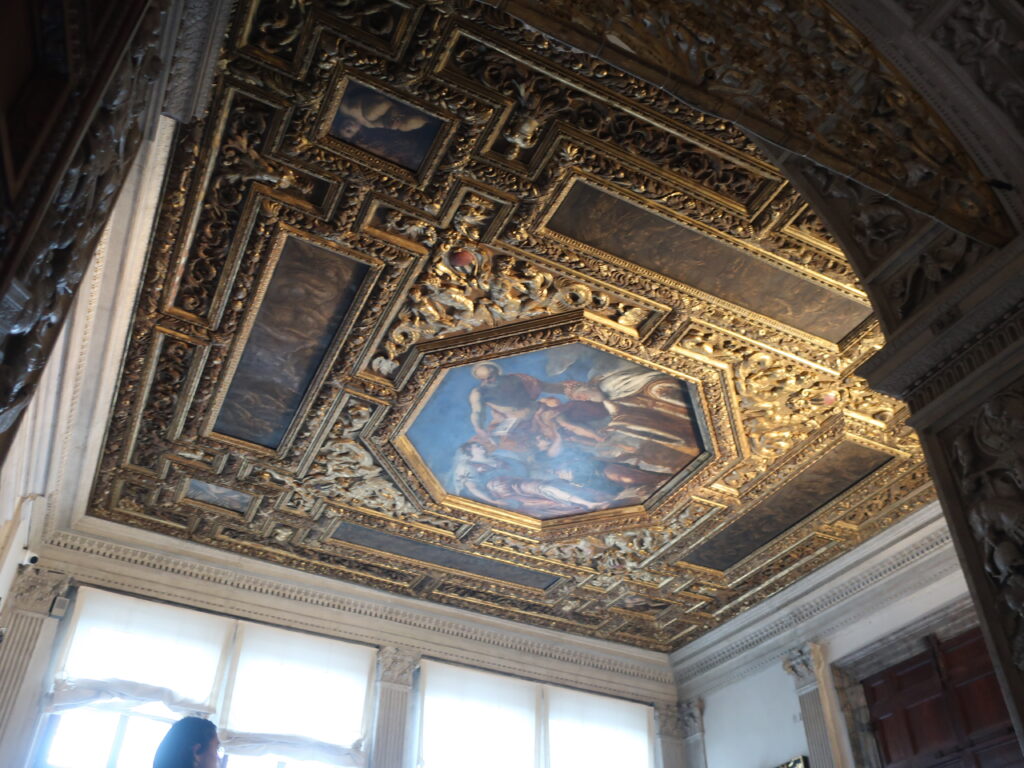
The most immediately noticeable thing upon entering the palace is the gorgeous ceiling paintings. The ceiling is covered with gold frames and colorful paintings.
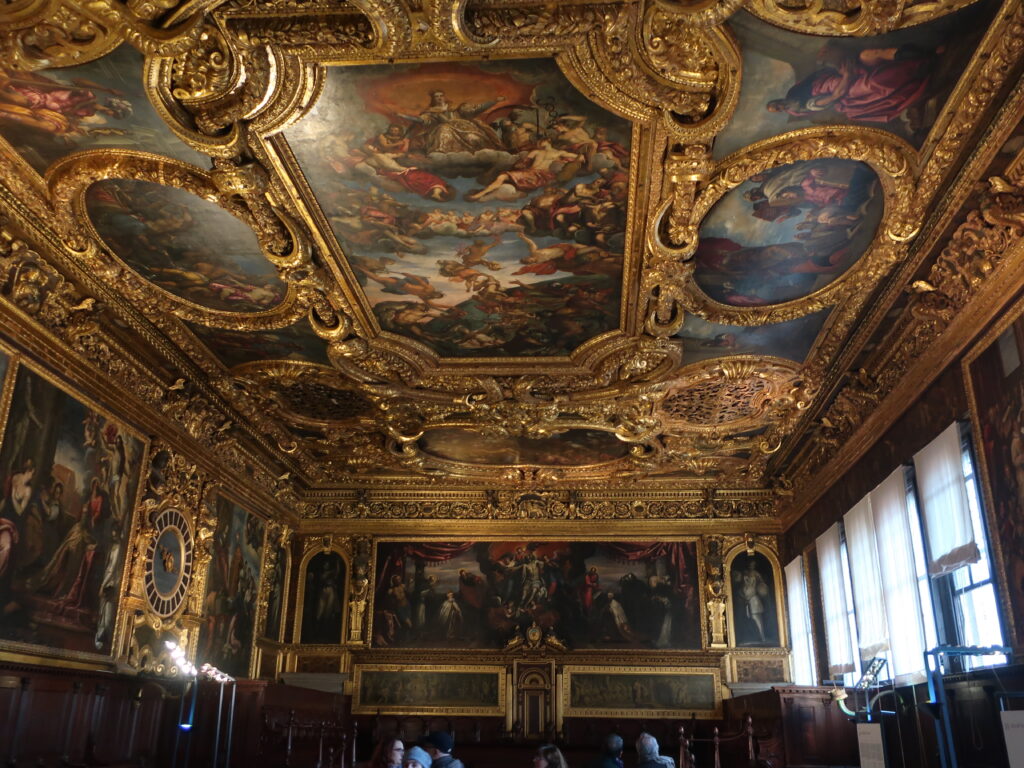
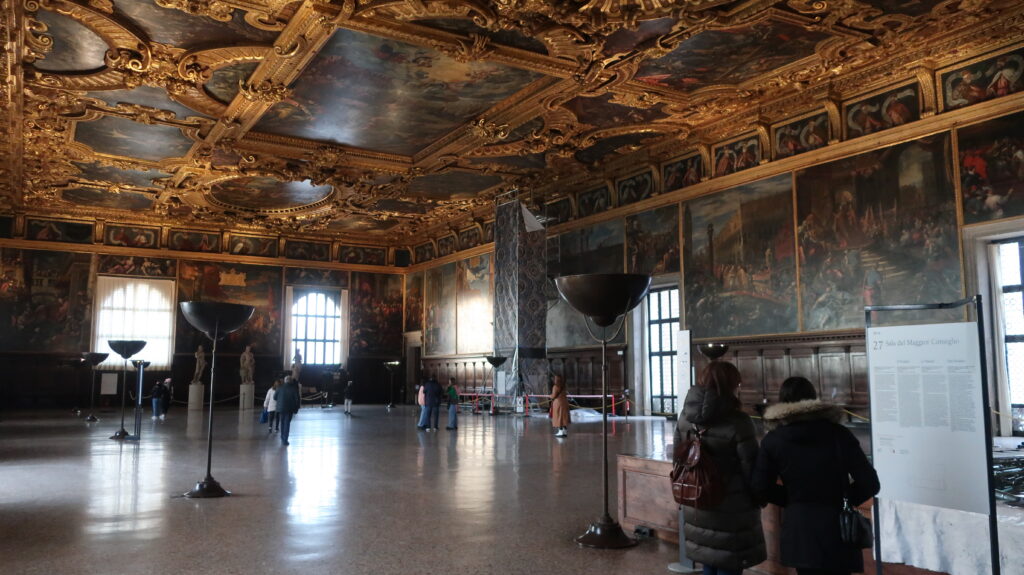
Anyway, ceiling! Ceiling! Ceiling!
I felt an insatiable passion to decorate the ceiling. The walls are naturally covered with paintings, but it is the ceiling! Clearly, the effort put into the ceiling is different.
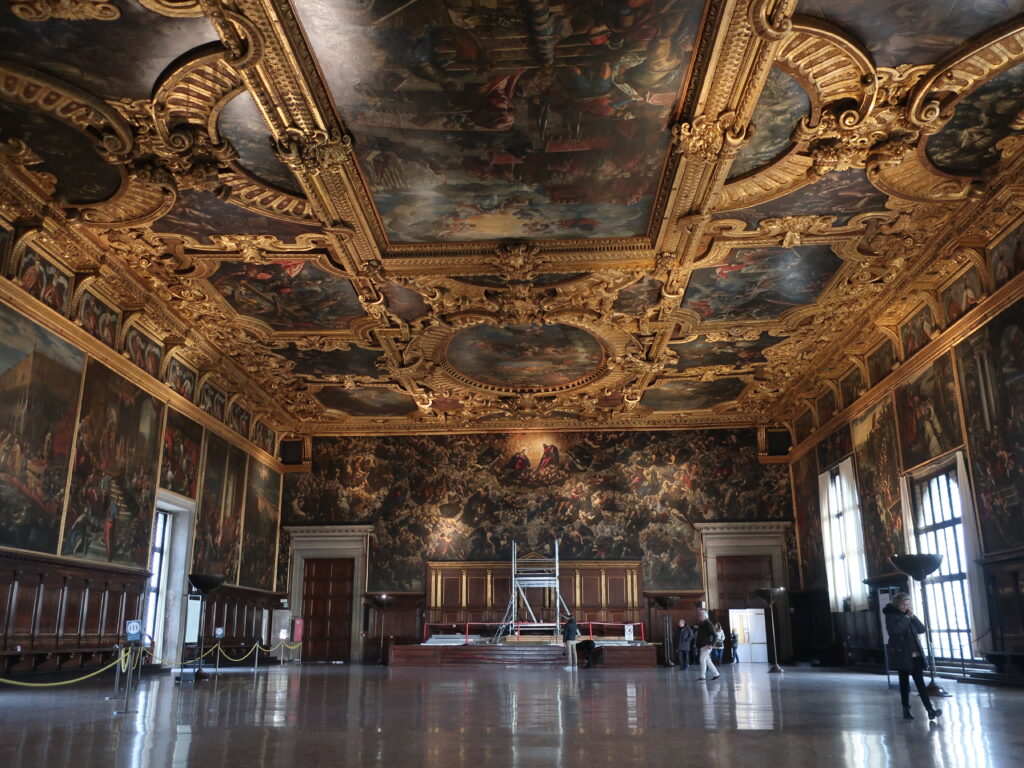
When I entered the room with the Tintoretto mural, a mysterious murmur of "I did it..." spontaneously escaped my mouth.
It is more like "craving" than passion. In a sense, it is admirable that the ceiling is decorated so far through. I can't stop opening my mouth.
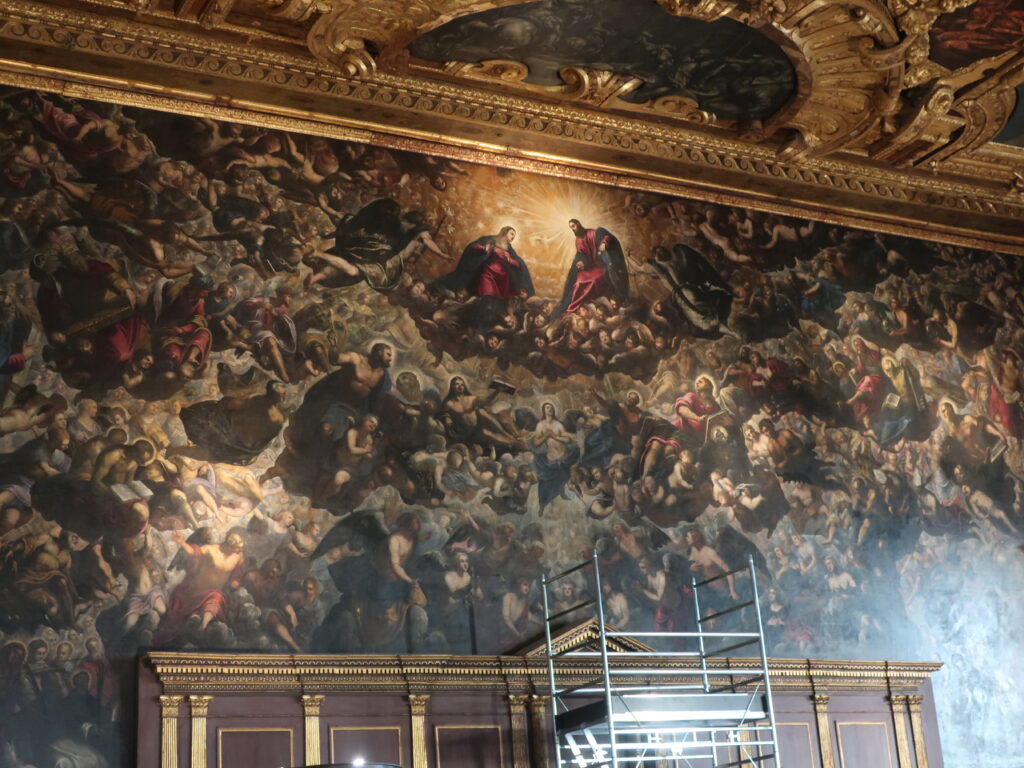
And the huge mural of Tintoretto is wonderful. It is truly a flood of people. A crowd of people as if a huge wave is crashing against them. Is this inspiration from the fact that this is a city by the sea that is frequently hit by floods? It is nothing short of overwhelming.
The next day I also visited the Accademia Gallery to admire Venetian paintings.

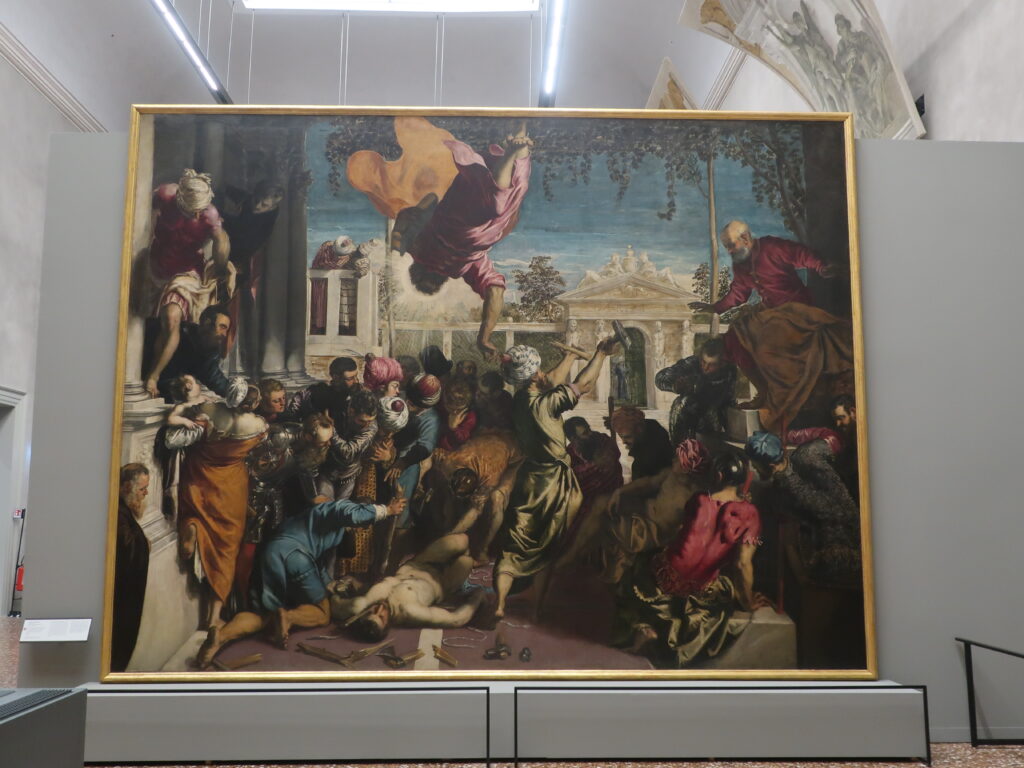
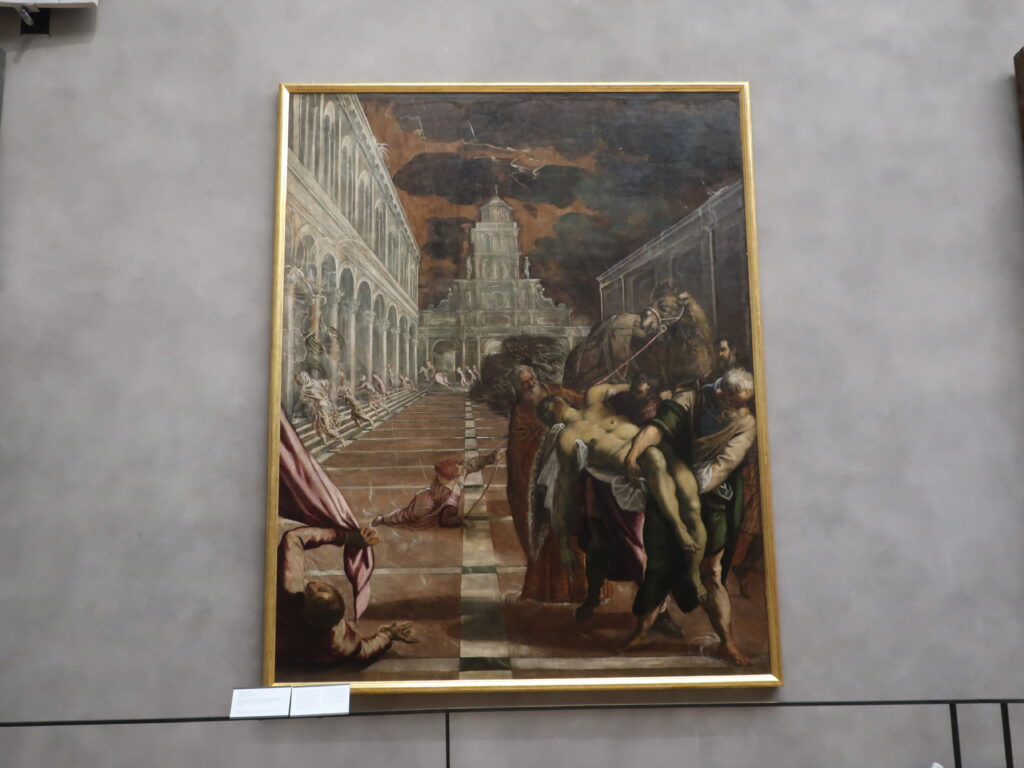
Venetian paintings are unique. The colors and dramatic compositions are instantly recognizable. I even feel a sense of intensity. I wonder if this is also the result of the unique culture of the Mediterranean Sea, which is different from the landlocked Milan and Florence. It is very interesting to visit different regions of Italy and feel the difference in atmosphere.
Thoughts on Venice through My Stay in Venice - Venice, a Theme Park City and Mr. and Mrs. Dostoevsky
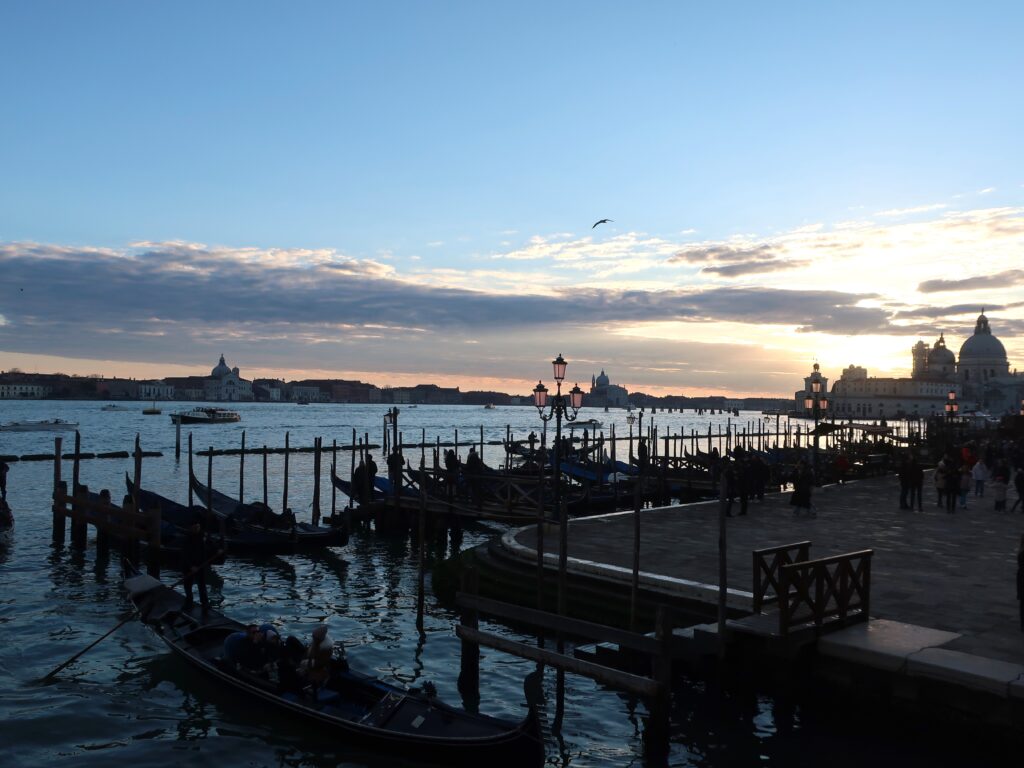
Venice at sunset ... unquestionably beautiful. I feel the full intensity of the colors.
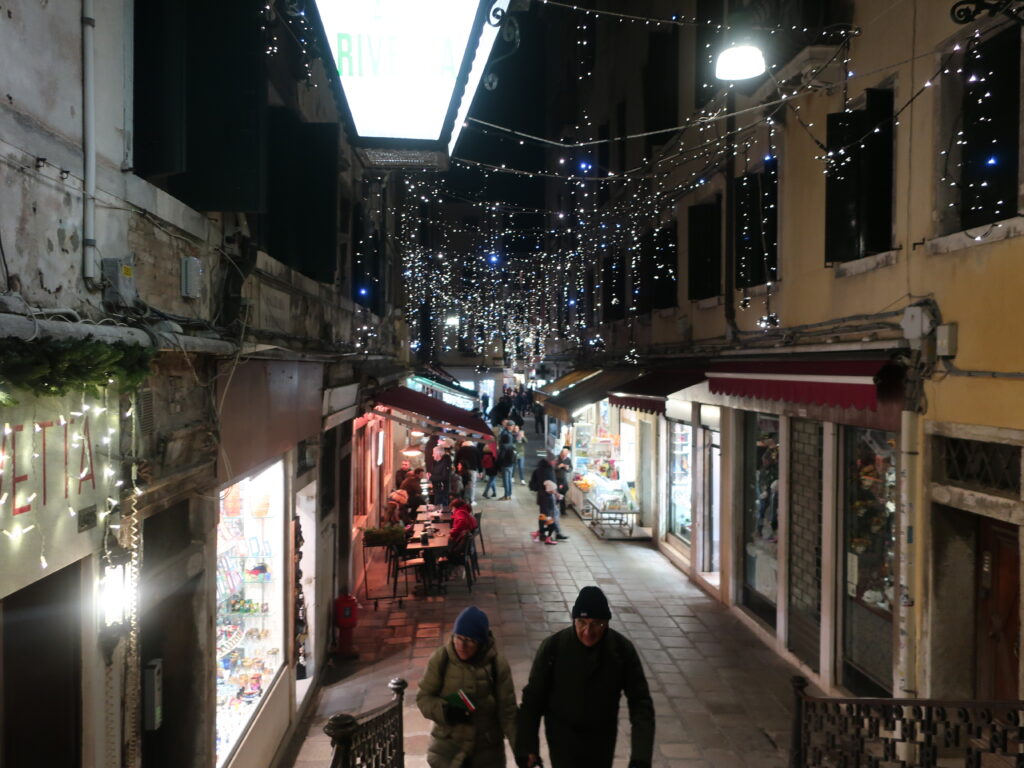
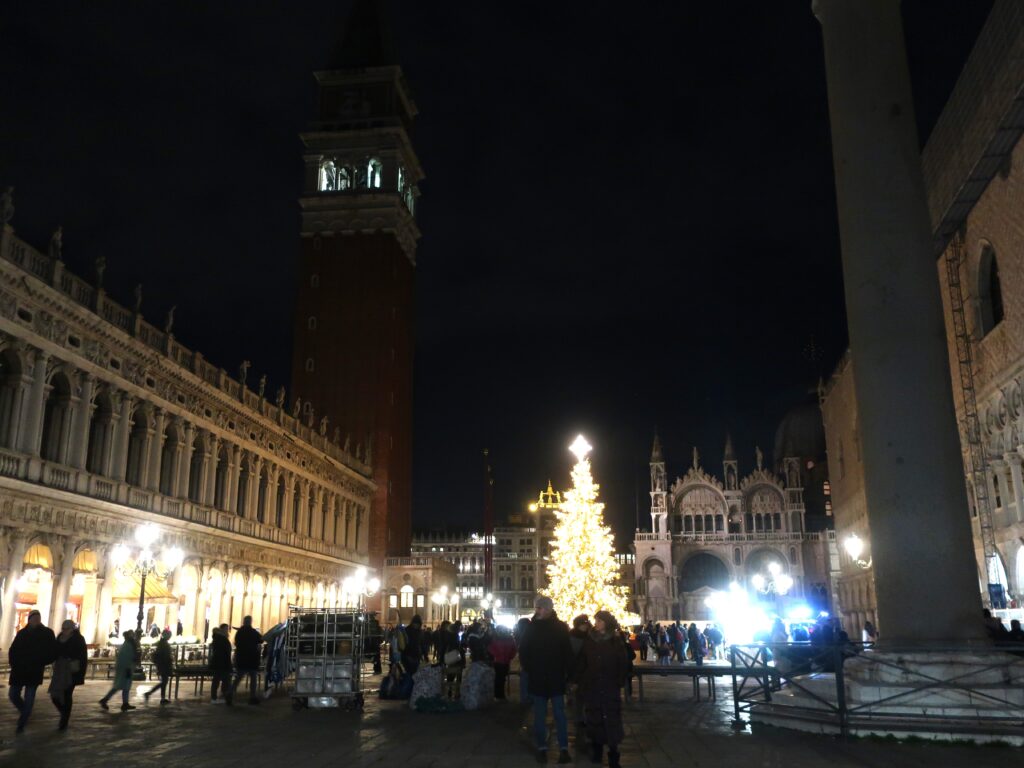
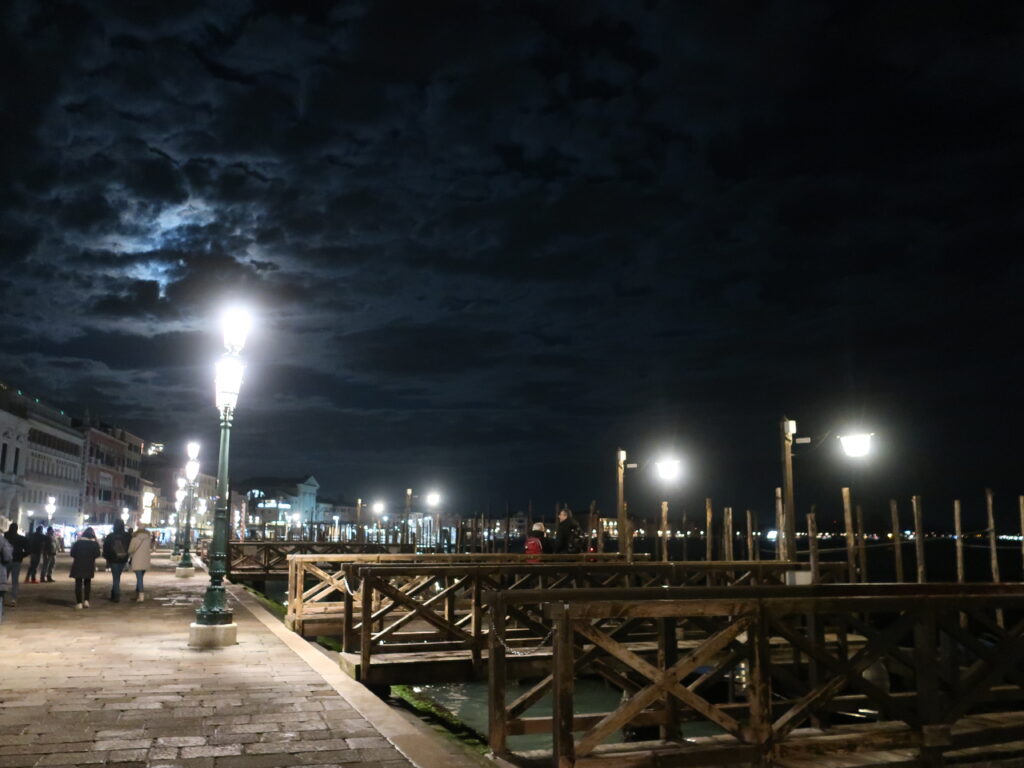
Night is night and everywhere you go, the mood is moody and romantic.............................
Me walking alone in such Venice: ・・・・
As you can imagine, I felt lonely here. Although I don't mind walking alone at all, I can't do so in this city. This is a city where I want to walk with my partner. It feels like a theme park. It is not like a theme park where you can watch art in silence by yourself. I think this is what makes it completely different from Rome and Florence. I think it is the best place to make memories with your partner.
And, as I realized upon my return to Japan, Dostoevsky apparently felt the same way. In his "Recollections," Mrs. Anna wrote,
We were in Venice for only three or four days, but he was so fascinated by the architecture of St. Mark's Basilica that he spent hours admiring the beautiful mosaic walls. They visited the Palazzo Ducale together, and my husband was in awe of its magnificent architecture. He was also entranced by the astonishing beauty of the ceiling of the Governor's Palace, which was painted by the best artists of the fifteenth century. It is safe to say that during our four days in Venice, we could not leave the Piazza San Marco, which left an enchanting impression day and night.
Misuzu Shobo, Anna Dostoevskaya, translated by Hiroshi MatsushitaDostoevsky in Recollection."p205
and he writes here that he raved about the beauty of Venice and enjoyed himself immensely, Dostoevsky wrote in a letter to A. N. Maikov, dated August 14, 1869, as follows.
Venice and Vienna were my wife's favorites (in their own way).
Kawade Shobo Shinsha, translated by Masao Yonekawa, The Complete Works of Dostoevsky 17, p. 258
What does this mean?
In fact, Dostoevsky says almost nothing about the Venetian paintings. Although he writes that Madame Anna enjoyed looking at the ceiling paintings with Dostoevsky, there is no comment by Dostoevsky about them. As we have seen, Dostoevsky is very sensitive about paintings. And as for the paintings that he was interested in, he described his impressions of them. This was true in Dresden, in Basel, in Florence, and in Bologna. But as for Venice, it is not the case.
But I suppose it would. In fact, I have seen the paintings in this city, and first of all, I don't think they are the type of paintings that Dostoevsky would have liked. Moreover, the fervently decorated ceiling paintings do not seem to fit Dostoevsky's view of art. Dostoevsky prefers harmony like Raphael. In that sense, the intense colors and overly dramatic composition of this city probably do not suit Dostoevsky's taste.
So Dostoevsky did not enjoy himself in this city?
I think that's not true either. Because Dostoevsky was with his beloved wife Anna.
I think they were having a romantic time in this city, which is like a theme park. That's why DostoevskyVenice and Vienna were my wife's favorites (in their own way)."I think he wrote the meaningful words, "I am a very good friend of Mikov's. He and Maikov are such good friends that they have quite a lot of standing around and discussing art and literature. As for Dostoevsky himself, the paintings in Venice did not impress him that much. But that was all right, because Mrs. Anna was very pleased with them. I think he said this with that kind of implication.
...Hmmm...am I thinking too much? I don't know the answer.
But if they both enjoyed their time in Venice, then I'm happy for them. They have suffered a lot so far. I hope you two will have a good time together. In another letter he wrote: "Venice, what a wonderful city! (to N. N. Strahov, August 14, 1869).
My stay in Venice was filled with thoughts of these two people.
be unbroken
Next Article.
Click here to read the previous article.
Click here for a list of Dostoevsky's recommended books.
List of recommended Dostoevsky biographies."
List of recommended Dostoevsky commentaries.
A list of recommended commentaries on "Dostoevsky and Christianity."
Related Articles











